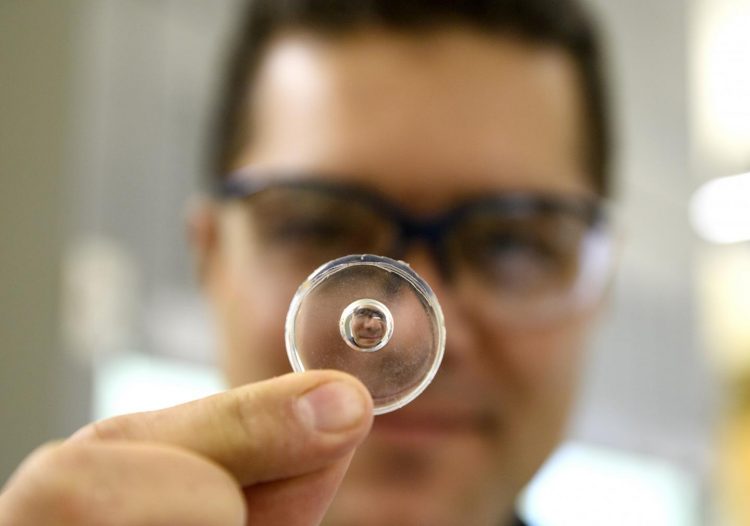Researchers develop new lens manufacturing technique

Graduate student Mojtaba Falahati holds a homemade lens. Credit: WSU
Led by Lei Li, assistant professor in the School of Mechanical and Materials Engineering, and graduate student, Mojtaba Falahati, the researchers developed a liquid mold from droplets that they can manipulate with magnets to create lenses in a variety of shapes and sizes. Their work is featured on the cover of the journal, Applied Physics Letters.
High-quality lenses are increasingly used in everything from cameras, to self-driving cars, and virtually all robotics, but the traditional molding and casting processes used in their manufacturing require sophisticated and expensive metal molds. So, manufacturers are mostly limited to mass producing one kind of lens.
“The molds are precisely finished and are difficult to make,” said Li. “It isn't worthwhile to make a mold for low-volume production.”
The researchers ran into the problem firsthand as they searched for lenses for their work to develop a portable laboratory reader on a phone.
They first tried to make their own lenses using 3D printing but found it difficult to control the lens shape. They then came up with the idea of using magnets and the surface tension of liquids to literally create free-flowing molds.
They placed tiny, magnetic iron particles into liquid droplets and built a device to surround the droplets with magnets. They then poured the plastic material used in lenses over the droplet. As they applied a magnetic field, the droplet took on a conical lens shape – creating a mold for the plastic lens material.
Once they cured the plastic, it hardened and had the same optical properties and imaging quality as a commercially purchased lens. The liquid droplet remains separate and can be re-used.
The magnets can be moved to change the magnetic field, the shape of the mold, and the resulting lens. The researchers also used bigger or smaller droplets to create lenses of varying sizes.
“We brought the concept of interfacial tension to the field of optics by introducing an innovative controllable liquid mold,” said Li. “This novel process allowed us to regulate the shape of a magnetic drop and to create lenses without having to fabricate expensive molds.”
###
The work was funded by the National Science Foundation.
Media Contact
All latest news from the category: Physics and Astronomy
This area deals with the fundamental laws and building blocks of nature and how they interact, the properties and the behavior of matter, and research into space and time and their structures.
innovations-report provides in-depth reports and articles on subjects such as astrophysics, laser technologies, nuclear, quantum, particle and solid-state physics, nanotechnologies, planetary research and findings (Mars, Venus) and developments related to the Hubble Telescope.
Newest articles

First-of-its-kind study uses remote sensing to monitor plastic debris in rivers and lakes
Remote sensing creates a cost-effective solution to monitoring plastic pollution. A first-of-its-kind study from researchers at the University of Minnesota Twin Cities shows how remote sensing can help monitor and…

Laser-based artificial neuron mimics nerve cell functions at lightning speed
With a processing speed a billion times faster than nature, chip-based laser neuron could help advance AI tasks such as pattern recognition and sequence prediction. Researchers have developed a laser-based…

Optimising the processing of plastic waste
Just one look in the yellow bin reveals a colourful jumble of different types of plastic. However, the purer and more uniform plastic waste is, the easier it is to…


